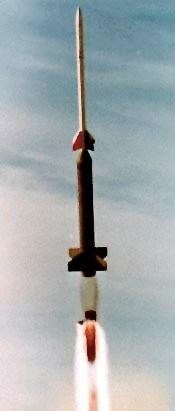In service 1966–1968 Weight 1,650 pounds (750 kg) | Place of origin United States | |
 | ||
Manufacturer U.S. Army Missile Command | ||
The XMQR-13A Ballistic Missile Target System (BMTS) was an unguided target rocket developed by the United States Army during the 1960s, intended for use in the development of missile defense systems. Utilising off-the-shelf parts in four different configurations, the BMTS was utitised in a series of launches in the late 1960s supporting tests of several missile systems.
Contents
Design and development
Developed by the U.S. Army Missile Command (USAMICOM), the Ballistic Missile Target System, or BMTS, was intended as a ballistic target rocket, utilising as many parts from existing missiles as possible, to be used in the development and evaluation of defense systems against ballistic missile attack.
Given the designation XMQR-13A in 1967, the BMTS could be launched in four different configurations. Configuration 1 used the booster from a Nike Ajax surface-to-air missile, with either an Apache (Version 1), Cajun (version 2), or inert Cajun (version 3) upper stage. Configuration 2 omitted the upper stage. All four variations fitted a radar enhancer in the nose cone to assist in target acquisition by the targeting missile.
Operational history
The XMQR-13A was used in a series of test firings between 1966 and 1968, primarily from the White Sands Missile Range, and using a modified Terrier portable launcher. The test launches supported a variety of antimissile development programs, including that of the HAWK, and was intended for use in the development of SAM-D.
The Nike-Apache and Nike-Cajun rocket configurations were also use extensively as sounding rockets for experimental missions conducted by NASA.
